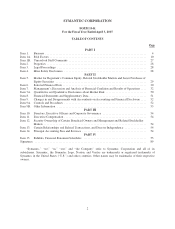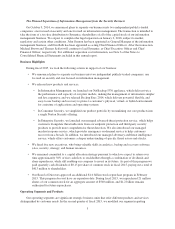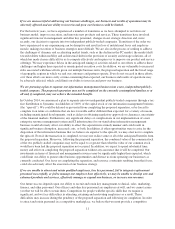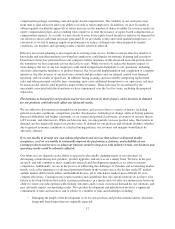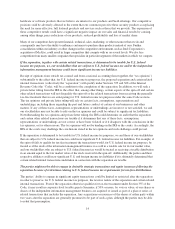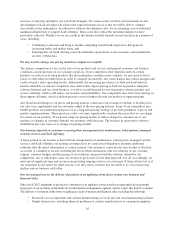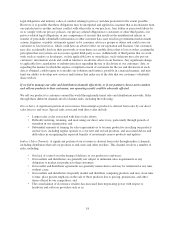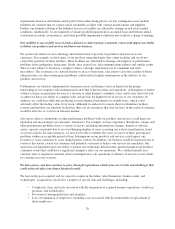Symantec 2015 Annual Report Download - page 90
Download and view the complete annual report
Please find page 90 of the 2015 Symantec annual report below. You can navigate through the pages in the report by either clicking on the pages listed below, or by using the keyword search tool below to find specific information within the annual report.compensation package, including cash and equity-based compensation. The volatility in our stock price may
from time to time adversely affect our ability to recruit or retain employees. In addition, we may be unable to
obtain required stockholder approvals of future increases in the number of shares available for issuance under our
equity compensation plans, and accounting rules require us to treat the issuance of equity-based compensation as
compensation expense. As a result, we may decide to issue fewer equity-based incentives and may be impaired in
our efforts to attract and retain necessary personnel. If we are unable to hire and retain qualified employees, or
conversely, if we fail to manage employee performance or reduce staffing levels when required by market
conditions, our business and operating results could be adversely affected.
Effective succession planning is also important to our long-term success. Failure to ensure effective transfer of
knowledge and smooth transitions involving key employees could hinder our strategic planning and execution.
From time to time, key personnel leave our company and the incidence of this increased in recent periods due to
the transitions we have experienced over the last few years. While we strive to reduce the negative impact of
such changes, the loss of any key employee could result in significant disruptions to our operations, including
adversely affecting the timeliness of product releases, the successful implementation and completion of company
initiatives, the effectiveness of our disclosure controls and procedures and our internal control over financial
reporting, and our results of operations. In addition, hiring, training, and successfully integrating replacement
sales and other personnel could be time consuming, may cause additional disruptions to our operations, and may
be unsuccessful, which could negatively impact future revenues. These risks may be exacerbated by the
uncertainty associated with the transitions we have experienced over the last few years, including the proposed
separation.
Fluctuations in demand for our products and services are driven by many factors, and a decrease in demand
for our products could adversely affect our financial results.
We are subject to fluctuations in demand for our products and services due to a variety of factors, including
general economic conditions, competition, product obsolescence, technological change, shifts in buying patterns,
financial difficulties and budget constraints of our current and potential customers, awareness of security threats
to IT systems, and other factors. While such factors may, in some periods, increase product sales, fluctuations in
demand can also negatively impact our product sales. If demand for our products and solutions declines, whether
due to general economic conditions or a shift in buying patterns, our revenues and margins would likely be
adversely affected.
If we are unable to develop new and enhanced products and services that achieve widespread market
acceptance, or if we are unable to continually improve the performance, features, and reliability of our
existing products and services or adapt our business model to keep pace with industry trends, our business and
operating results could be adversely affected.
Our future success depends on our ability to respond to the rapidly changing needs of our customers by
developing or introducing new products, product upgrades, and services on a timely basis. We have in the past
incurred, and will continue to incur, significant research and development expenses as we strive to remain
competitive. Additionally, we are in the process of addressing the challenges of dynamic and accelerating market
trends, such as the emergence of advanced persistent threats in the security space, the decline in the PC market,
and the market shift towards tablets and handheld devices, all of which have made it more difficult for us to
compete effectively. Customers may require features and capabilities that our current solutions do not have. Our
failure to develop solutions that satisfy customer preferences in a timely and cost-effective manner may harm our
ability to renew our subscriptions with existing customers and to create or increase demand for our solutions, and
may adversely impact our operating results. New product development and introduction involves a significant
commitment of time and resources and is subject to a number of risks and challenges including:
• Managing the length of the development cycle for new products and product enhancements, which has
frequently been longer than we originally expected;
12


